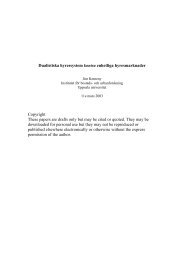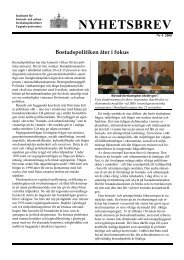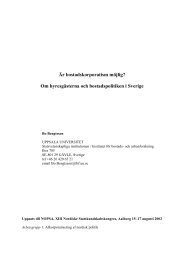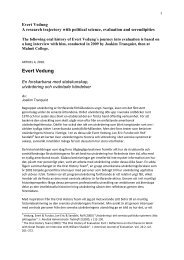Potentials and planning strategies for a positive development
Potentials and planning strategies for a positive development
Potentials and planning strategies for a positive development
Create successful ePaper yourself
Turn your PDF publications into a flip-book with our unique Google optimized e-Paper software.
ticipation <strong>for</strong> sustainable <strong>development</strong> of <strong>for</strong>mer military sites. One of the<br />
proposed approaches Participatory Action Research was an inspiration to<br />
carry out stakeholders’ workshop <strong>and</strong> groups interviews <strong>and</strong> to map out the<br />
current <strong>planning</strong> situation <strong>and</strong> discuss <strong>planning</strong> <strong>strategies</strong> <strong>for</strong> the future. In<br />
order to analyze the data, the researchers compared data from different<br />
sources.<br />
Selection of cases<br />
The Swedish partners have done a comparative case study based on three<br />
cases: Marciena, Liepa <strong>and</strong> Valga, all located in Eastern Europe. Selection<br />
criterion was to find contrasting cases. Selected cases differ in size, location<br />
(peripheral or central) <strong>and</strong> the potential <strong>for</strong> <strong>positive</strong> <strong>development</strong>. In addition<br />
they have been rationally selected on basis of previous ReMiDo-research,<br />
explicit:<br />
• A typology (categories <strong>and</strong> indicators <strong>for</strong> categorizing) of cases<br />
of post-Soviet residential military areas in Estonia, Latvia <strong>and</strong><br />
Lithuania, outlined by Uwe Sassenberg (figure 1) 5<br />
• The three objects represent two different categories of cases:<br />
Valga has middle potential <strong>for</strong> <strong>positive</strong> <strong>development</strong>, Marciena<br />
<strong>and</strong> Liepa has low potential<br />
Figure 1. Cases of post-Soviet military areas in Estonia, Latvia <strong>and</strong><br />
Lithuania (cities, trend <strong>and</strong> potential)<br />
Historical<br />
Nonhistorical<br />
The trend-variable presumes historical <strong>and</strong> non-historical cases: historical<br />
cases as old-fashioned buildings <strong>and</strong> environment with attractive water-<br />
5 Uwe Sassenberg, typology presented at ReMiDo Steering Committee Meeting in Riga 17<br />
January 2007.<br />
Trend<br />
Kaunas<br />
Vilnius<br />
Liepaja<br />
Paldiski<br />
Valga<br />
Gorzow<br />
High Middle Low<br />
Marciena<br />
Liepa<br />
Potential<br />
7






